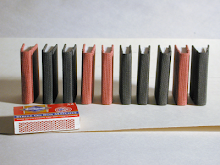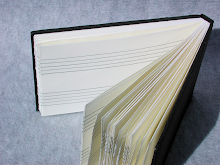People ask me how I manage both an over-the-road career and my art. For the most part I can manage it because it is all one interwoven, tightly knotted mess. Much of art is mindless, mind-numbing nothing with the occassional spark of something useful. I have chosen to use the road to channel the nothing part. The road even allows me an income and something to focus on outside a studio.

The doing-it part then becomes framed by the road part. A lot of studio time involves piddling about. I save the piddling for when I'm on the road and try to do as much piddling on the road, so that when it comes time for the quality studio time I can get the job done in an efficient manner. All the planning, designing, and inventing is done ahead of time. By the time I get to the studio (many times it's just a kitchen table), I have thought through all my construction methods and proportions, and can go right straight to work. If new ideas come about during the implementation phase, I'll ad lib only so far that it doesn't interfere with completing the project. If the new idea calls for a major redirection, I save the idea for the next project.
Technically, I could make my little books entirely in my vehicle. In reality I end up working more efficiently by only taking care of small repetitive jobs like stitching together pre-stacked signatures, or making small wire parts for mechanical projects. I save clumbsy and messy jobs like tearing paper and gluing things for when I can work outside the vehicle. I have small stashes of supplies with a few family and friends scattered across the country who then allow me a place to work when I come off the road or when freight gets slow.
I am in high production when freight is low. I'll park at one of my supply points and work on projects taking care to only take on projects that I can dump at a moments notice, because when a load offer comes in I have to be ready to roll. I'll route myself back to the supply point until freight picks back up and then I'm back into the road mode. I save my home time for when I want to take care of more involved work and for work in the gallery. Inspite of what could potentially be a great detractor from a driving career, I still manage to keep all my driving statistics like load acceptance, on-time, and in-service time at a high level.

 The last couple years I slept on a folding camp cot. When I needed room for a large load of freight, I stored the cot and slept on the floor. Sometimes there was hardly enough room to sleep on the floor. The solution was a storable bunk that folds into the wall shelves that I made by modifying components of an ikea shelf system. The shelves are shallow enough that pallets that can clear the wheel-wells can clear the shelves, and the bunk is narrow enough that three pallets will fit whether the bunk is folded away or open.
The last couple years I slept on a folding camp cot. When I needed room for a large load of freight, I stored the cot and slept on the floor. Sometimes there was hardly enough room to sleep on the floor. The solution was a storable bunk that folds into the wall shelves that I made by modifying components of an ikea shelf system. The shelves are shallow enough that pallets that can clear the wheel-wells can clear the shelves, and the bunk is narrow enough that three pallets will fit whether the bunk is folded away or open.













